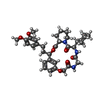[English] 日本語
 Yorodumi
Yorodumi- PDB-7aot: The Fk1 domain of FKBP51 in complex with (2R,5S,12R)-12-cyclohexy... -
+ Open data
Open data
- Basic information
Basic information
| Entry | Database: PDB / ID: 7aot | ||||||
|---|---|---|---|---|---|---|---|
| Title | The Fk1 domain of FKBP51 in complex with (2R,5S,12R)-12-cyclohexyl-2-[2-(3,4-dimethoxyphenyl)ethyl]-3,19-dioxa-10,13,16-triazatricyclo[18.3.1.0-5,10]tetracosa- 1(24),20,22-triene-4,11,14,17-tetrone | ||||||
 Components Components | Peptidyl-prolyl cis-trans isomerase FKBP5 | ||||||
 Keywords Keywords | CHAPERONE / Fk-506 binding domain / Hsp90 cochaperone / immunophiline / peptidyl-prolyl isomerase / ligand selectivity | ||||||
| Function / homology |  Function and homology information Function and homology informationModulation of host responses by IFN-stimulated genes / response to alcohol / FK506 binding / MECP2 regulates neuronal receptors and channels / : / heat shock protein binding / ESR-mediated signaling / HSP90 chaperone cycle for steroid hormone receptors (SHR) in the presence of ligand / response to cocaine / response to bacterium ...Modulation of host responses by IFN-stimulated genes / response to alcohol / FK506 binding / MECP2 regulates neuronal receptors and channels / : / heat shock protein binding / ESR-mediated signaling / HSP90 chaperone cycle for steroid hormone receptors (SHR) in the presence of ligand / response to cocaine / response to bacterium / peptidylprolyl isomerase / peptidyl-prolyl cis-trans isomerase activity / protein folding / protein-macromolecule adaptor activity / extracellular exosome / nucleoplasm / membrane / cytoplasm / cytosol Similarity search - Function | ||||||
| Biological species |  Homo sapiens (human) Homo sapiens (human) | ||||||
| Method |  X-RAY DIFFRACTION / X-RAY DIFFRACTION /  SYNCHROTRON / SYNCHROTRON /  MOLECULAR REPLACEMENT / MOLECULAR REPLACEMENT /  molecular replacement / Resolution: 0.85 Å molecular replacement / Resolution: 0.85 Å | ||||||
 Authors Authors | Voll, A.M. / Meyners, C. / Heymann, T. / Merz, S. / Purder, P. / Bracher, A. / Hausch, F. | ||||||
 Citation Citation |  Journal: Angew.Chem.Int.Ed.Engl. / Year: 2021 Journal: Angew.Chem.Int.Ed.Engl. / Year: 2021Title: Macrocyclic FKBP51 Ligands Define a Transient Binding Mode with Enhanced Selectivity. Authors: Voll, A.M. / Meyners, C. / Taubert, M.C. / Bajaj, T. / Heymann, T. / Merz, S. / Charalampidou, A. / Kolos, J. / Purder, P.L. / Geiger, T.M. / Wessig, P. / Gassen, N.C. / Bracher, A. / Hausch, F. #1:  Journal: Acta Crystallogr D Biol Crystallogr / Year: 2011 Journal: Acta Crystallogr D Biol Crystallogr / Year: 2011Title: Structural characterization of the PPIase domain of FKBP51, a cochaperone of human Hsp90. Authors: Bracher, A. / Kozany, C. / Thost, A.K. / Hausch, F. | ||||||
| History |
|
- Structure visualization
Structure visualization
| Structure viewer | Molecule:  Molmil Molmil Jmol/JSmol Jmol/JSmol |
|---|
- Downloads & links
Downloads & links
- Download
Download
| PDBx/mmCIF format |  7aot.cif.gz 7aot.cif.gz | 129.3 KB | Display |  PDBx/mmCIF format PDBx/mmCIF format |
|---|---|---|---|---|
| PDB format |  pdb7aot.ent.gz pdb7aot.ent.gz | 100.3 KB | Display |  PDB format PDB format |
| PDBx/mmJSON format |  7aot.json.gz 7aot.json.gz | Tree view |  PDBx/mmJSON format PDBx/mmJSON format | |
| Others |  Other downloads Other downloads |
-Validation report
| Summary document |  7aot_validation.pdf.gz 7aot_validation.pdf.gz | 716.2 KB | Display |  wwPDB validaton report wwPDB validaton report |
|---|---|---|---|---|
| Full document |  7aot_full_validation.pdf.gz 7aot_full_validation.pdf.gz | 717.4 KB | Display | |
| Data in XML |  7aot_validation.xml.gz 7aot_validation.xml.gz | 10.3 KB | Display | |
| Data in CIF |  7aot_validation.cif.gz 7aot_validation.cif.gz | 15.4 KB | Display | |
| Arichive directory |  https://data.pdbj.org/pub/pdb/validation_reports/ao/7aot https://data.pdbj.org/pub/pdb/validation_reports/ao/7aot ftp://data.pdbj.org/pub/pdb/validation_reports/ao/7aot ftp://data.pdbj.org/pub/pdb/validation_reports/ao/7aot | HTTPS FTP |
-Related structure data
| Related structure data |  7aouC 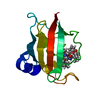 7awfC  3o5qS S: Starting model for refinement C: citing same article ( |
|---|---|
| Similar structure data |
- Links
Links
- Assembly
Assembly
| Deposited unit | 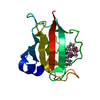
| ||||||||
|---|---|---|---|---|---|---|---|---|---|
| 1 |
| ||||||||
| Unit cell |
|
- Components
Components
| #1: Protein | Mass: 14026.077 Da / Num. of mol.: 1 / Fragment: Fk1 domain Mutation: additional N-terminal sequence GAP, cloning artefact, mutation A19T Source method: isolated from a genetically manipulated source Source: (gene. exp.)  Homo sapiens (human) / Gene: FKBP5, AIG6, FKBP51 / Plasmid: pProEx-HtB / Production host: Homo sapiens (human) / Gene: FKBP5, AIG6, FKBP51 / Plasmid: pProEx-HtB / Production host:  |
|---|---|
| #2: Chemical | ChemComp-RTQ / ( |
| #3: Water | ChemComp-HOH / |
| Has ligand of interest | Y |
-Experimental details
-Experiment
| Experiment | Method:  X-RAY DIFFRACTION / Number of used crystals: 1 X-RAY DIFFRACTION / Number of used crystals: 1 |
|---|
- Sample preparation
Sample preparation
| Crystal | Density Matthews: 2.31 Å3/Da / Density % sol: 46.65 % / Mosaicity: 0.05 ° |
|---|---|
| Crystal grow | Temperature: 293 K / Method: vapor diffusion, hanging drop / pH: 7.5 Details: 38 % PEG-3350, 0.2 M NH4-acetate and 0.1 M HEPES-NaOH pH 7.5 |
-Data collection
| Diffraction | Mean temperature: 100 K / Serial crystal experiment: N | ||||||||||||||||||||||||||||||
|---|---|---|---|---|---|---|---|---|---|---|---|---|---|---|---|---|---|---|---|---|---|---|---|---|---|---|---|---|---|---|---|
| Diffraction source | Source:  SYNCHROTRON / Site: SYNCHROTRON / Site:  ESRF ESRF  / Beamline: ID30B / Wavelength: 0.82656 Å / Beamline: ID30B / Wavelength: 0.82656 Å | ||||||||||||||||||||||||||||||
| Detector | Type: DECTRIS PILATUS 6M / Detector: PIXEL / Date: Dec 15, 2015 | ||||||||||||||||||||||||||||||
| Radiation | Protocol: SINGLE WAVELENGTH / Monochromatic (M) / Laue (L): M / Scattering type: x-ray | ||||||||||||||||||||||||||||||
| Radiation wavelength | Wavelength: 0.82656 Å / Relative weight: 1 | ||||||||||||||||||||||||||||||
| Reflection | Resolution: 0.85→49.63 Å / Num. obs: 111218 / % possible obs: 97.1 % / Redundancy: 5.7 % / CC1/2: 0.999 / Rmerge(I) obs: 0.033 / Rpim(I) all: 0.014 / Rrim(I) all: 0.036 / Net I/σ(I): 22.1 / Num. measured all: 630447 | ||||||||||||||||||||||||||||||
| Reflection shell | Diffraction-ID: 1
|
-Phasing
| Phasing | Method:  molecular replacement molecular replacement | ||||||
|---|---|---|---|---|---|---|---|
| Phasing MR |
|
- Processing
Processing
| Software |
| |||||||||||||||||||||||||||||||||||||||||||||||||||||||||||||||||||||||||||
|---|---|---|---|---|---|---|---|---|---|---|---|---|---|---|---|---|---|---|---|---|---|---|---|---|---|---|---|---|---|---|---|---|---|---|---|---|---|---|---|---|---|---|---|---|---|---|---|---|---|---|---|---|---|---|---|---|---|---|---|---|---|---|---|---|---|---|---|---|---|---|---|---|---|---|---|---|
| Refinement | Method to determine structure:  MOLECULAR REPLACEMENT MOLECULAR REPLACEMENTStarting model: pdbid 3O5Q Resolution: 0.85→30 Å / Cor.coef. Fo:Fc: 0.982 / Cor.coef. Fo:Fc free: 0.978 / WRfactor Rfree: 0.1399 / WRfactor Rwork: 0.121 / FOM work R set: 0.9248 / SU B: 0.295 / SU ML: 0.008 / SU R Cruickshank DPI: 0.0126 / SU Rfree: 0.0135 / Cross valid method: THROUGHOUT / σ(F): 0 / ESU R: 0.013 / ESU R Free: 0.013 / Stereochemistry target values: MAXIMUM LIKELIHOOD Details: HYDROGENS HAVE BEEN ADDED IN THE RIDING POSITIONS U VALUES : REFINED INDIVIDUALLY
| |||||||||||||||||||||||||||||||||||||||||||||||||||||||||||||||||||||||||||
| Solvent computation | Ion probe radii: 0.8 Å / Shrinkage radii: 0.8 Å / VDW probe radii: 1.2 Å / Solvent model: MASK | |||||||||||||||||||||||||||||||||||||||||||||||||||||||||||||||||||||||||||
| Displacement parameters | Biso max: 89.37 Å2 / Biso mean: 12.227 Å2 / Biso min: 4.95 Å2
| |||||||||||||||||||||||||||||||||||||||||||||||||||||||||||||||||||||||||||
| Refinement step | Cycle: final / Resolution: 0.85→30 Å
| |||||||||||||||||||||||||||||||||||||||||||||||||||||||||||||||||||||||||||
| Refine LS restraints |
| |||||||||||||||||||||||||||||||||||||||||||||||||||||||||||||||||||||||||||
| LS refinement shell | Resolution: 0.85→0.872 Å / Rfactor Rfree error: 0 / Total num. of bins used: 20
|
 Movie
Movie Controller
Controller


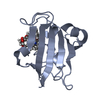
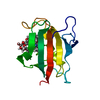
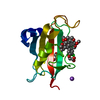
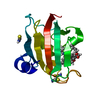

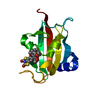
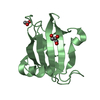

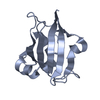
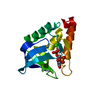
 PDBj
PDBj











